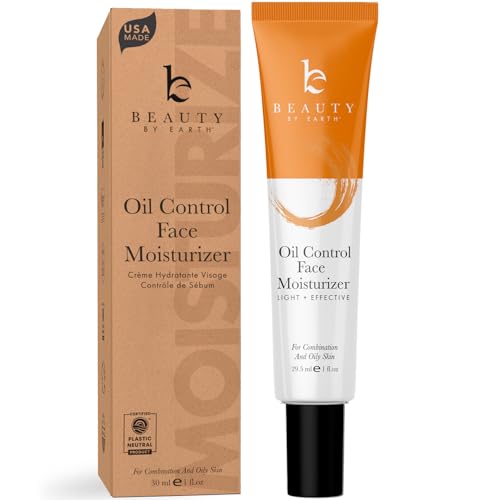
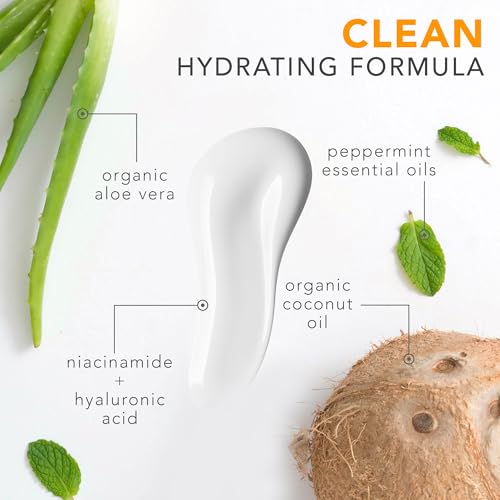
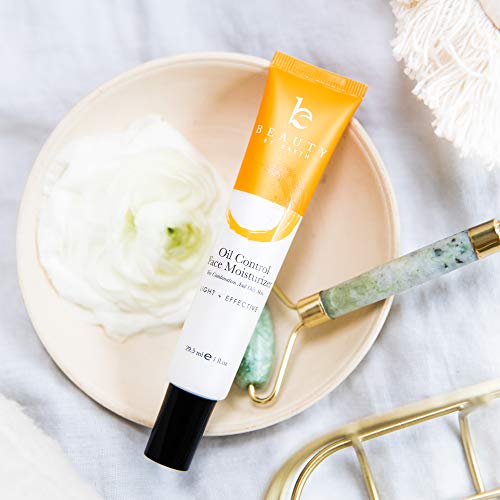
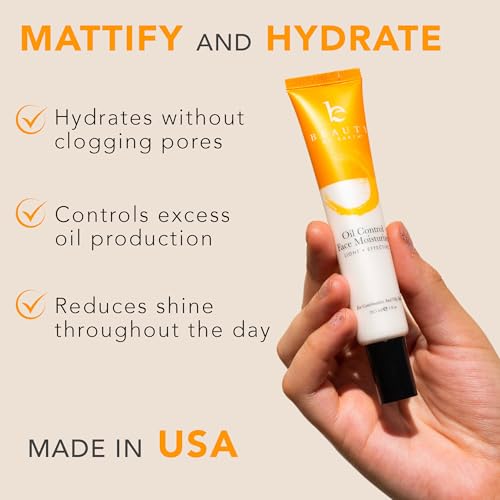
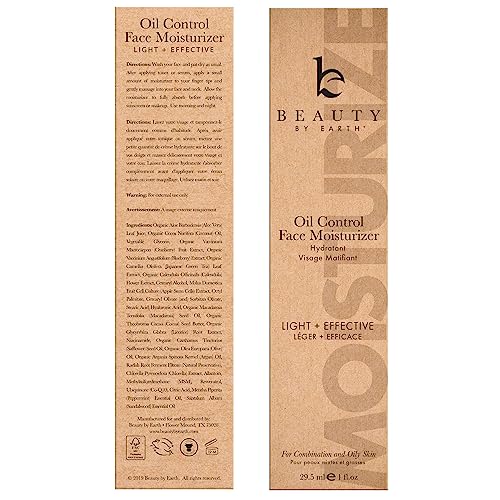
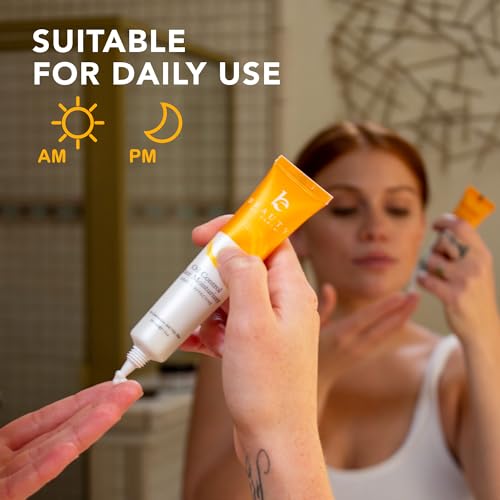
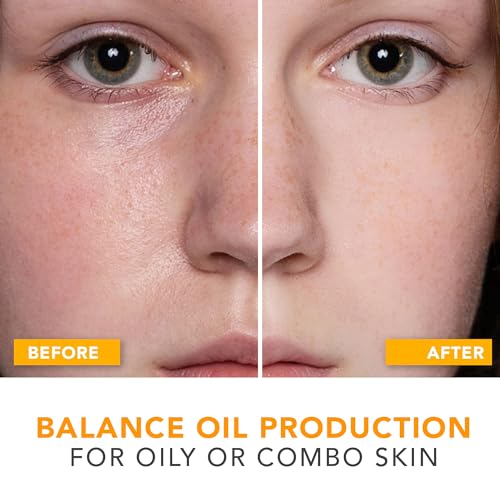
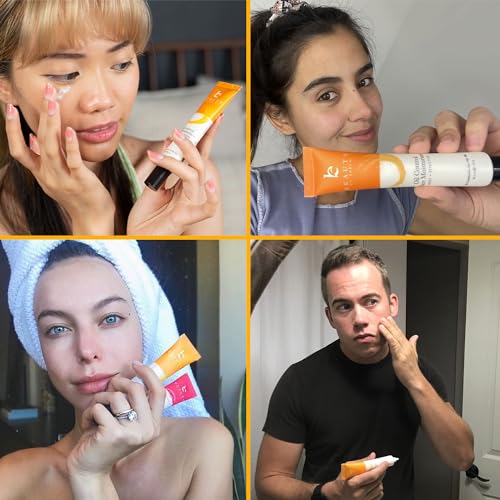
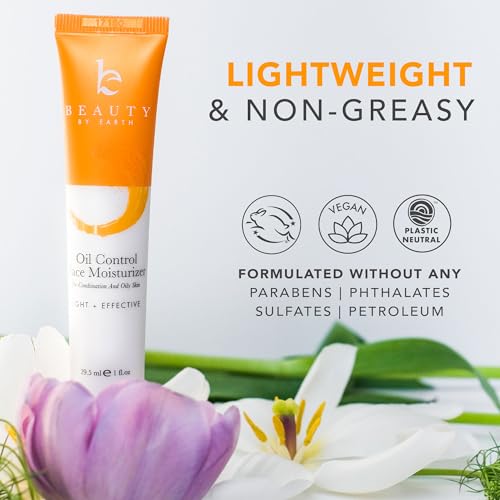
Oil Control Face Moisturizer - Lightweight Hydration with Niacinamide, USA Made - 4oz


Santalum Album (Sandalwood) Oil
High RiskSantalum album (sandalwood) oil is a volatile essential oil derived from the heartwood of the sandalwood tree. It is commonly used in fragrances, cosmetics, and aromatherapy for its aromatic properties and potential therapeutic benefits.
Sustai Insights
Sandalwood oil provides functional benefits in products as a fragrance and potential skin-conditioning agent. However, it presents a high allergenic potential and concerns regarding enhanced skin absorption, which may lead to adverse effects. Environmental risks include concerns about sustainability and potential pollutant status in its extraction process. Regulatory frameworks impose restrictions on its use due to safety concerns. Overall, the risk level is high, and users are advised to consider safer alternatives if available.
Mentha Piperita (Peppermint) Oil
High RiskMentha piperita (peppermint) oil is a volatile oil extracted from the leaves of the peppermint plant, known for its strong aroma and flavor. It is commonly used in cosmetics and personal care products for its cooling properties and fragrance enhancement.
Sustai Insights
Peppermint oil offers functional benefits such as antimicrobial properties and a soothing sensation on the skin. However, it is associated with a high potential for allergies and skin irritation. Regulatory bodies impose certain restrictions on its use due to these concerns. The overall risk level is assessed as high, warranting caution in usage, especially for sensitive populations. Alternatives like spearmint oil may provide similar benefits with potentially lower irritation risks.
Ubiquinone
Medium RiskUbiquinone, also known as coenzyme Q10, is a naturally occurring antioxidant found in the body, primarily in the mitochondria. It plays a crucial role in energy production and is commonly used in skincare and dietary supplements for its potential health benefits and ability to support cellular function.
Sustai Insights
Ubiquinone provides functional benefits as an antioxidant, aiding in energy production and skin health. It is generally considered safe, with low risks for carcinogenicity, allergies, and immunotoxicity, although moderate concerns exist regarding developmental and reproductive toxicity and certain usage restrictions. Environmental impacts are minimal, with no significant bioaccumulation noted. Regulatory bodies do not impose severe restrictions, but users should adhere to recommended concentrations. Overall, this ingredient presents a medium risk level, and alternatives like alpha-lipoic acid may be considered for those seeking different antioxidant options.
Glycyrrhiza Glabra (Licorice) Root Extract
Medium RiskGlycyrrhiza glabra (licorice) root extract is derived from the root of the licorice plant and is commonly used in cosmetic formulations for its soothing properties. It is known for its ability to impart a sweet flavor and is utilized for its skin-brightening and anti-inflammatory effects.
Sustai Insights
Licorice root extract offers functional benefits such as skin soothing and anti-inflammatory properties, making it valuable in cosmetic formulations. It is sourced sustainably; however, it poses low to moderate health risks, including potential allergenic effects and endocrine disruption. Environmental concerns are minimal, with no significant pollutant or bioaccumulation potential. Regulatory bodies restrict its use in certain concentrations, leading to a moderate overall risk assessment. Safe usage practices should be adhered to, and alternatives like chamomile extract may be considered for those seeking lower risk options.
Glycerin
Medium RiskGlycerin (also called glycerol) is a naturally occurring compound commonly used in personal care and cosmetic products. It functions as a humectant, attracting moisture to the skin, and is also utilized as a solvent and emollient to enhance product texture and stability.
Sustai Insights
Glycerin is valued for its effective moisturizing properties and biodegradability, making it a widely accepted ingredient in formulations. It poses low health risks, including low concerns for carcinogenicity and allergies. However, moderate use restrictions exist due to regulatory guidelines. While glycerin does not significantly contribute to environmental pollution, its production process should be ethically sourced. Overall, glycerin holds a medium risk level, emphasizing the importance of safe usage practices and considering sustainable alternatives.
Citric Acid
Medium RiskCitric acid is an alpha hydroxy acid used in personal care products primarily for its role as a pH adjuster and natural preservative. It occurs naturally in citrus fruits and is commonly utilized in various formulations for its chelating properties and mild exfoliation benefits.
Sustai Insights
Citric acid offers functional benefits as an effective preservative and pH stabilizer, contributing to product longevity and stability. It is biodegradable and derived from renewable sources. Health risks are low, with minimal concerns regarding carcinogenicity, allergies, and reproductive toxicity. However, moderate use restrictions exist due to potential irritation at high concentrations. Environmental risks are limited, as citric acid is not known to accumulate in ecosystems. Regulatory agencies have no significant advisories against its use. Overall, it is assessed as a medium-risk ingredient, with safe usage practices recommended and alternatives available.
Calendula Officinalis (Pot Marigold) Flower Extract
Low RiskExtract of the Calendula (Calendula officinalis) flower, commonly known as pot marigold, is utilized in cosmetic formulations for its soothing and anti-inflammatory properties. It is often included in creams, lotions, and ointments to promote skin health and healing.
Sustai Insights
Calendula officinalis flower extract offers functional benefits such as skin soothing and anti-inflammatory effects, making it valuable in topical applications. It is considered low risk for health impacts, with minimal concerns regarding carcinogenicity, allergies, or reproductive toxicity. Environmentally, it presents low pollution potential and is not bioaccumulative. Regulatory bodies have not imposed significant restrictions. Safe usage practices should be followed, and while alternatives exist, this extract is generally regarded as a low-risk option for cosmetic use.
Vaccinium Macrocarpon (Cranberry) Fruit Extract
Low RiskVaccinium macrocarpon (cranberry) fruit extract is derived from the fruit of the cranberry plant. It is commonly used in cosmetic and personal care products for its antioxidant properties and ability to provide moisture and nourishment to the skin.
Sustai Insights
Cranberry fruit extract offers functional benefits such as antioxidant protection and skin hydration, contributing positively to product efficacy. It is sustainably sourced and generally recognized as safe, presenting low health risks, including minimal concerns for carcinogenicity and irritation. Environmental impacts are low, with no significant pollutant or bioaccumulation concerns. Regulatory assessments indicate no restrictions. Overall, cranberry fruit extract is considered low risk, and safe usage practices involve normal cosmetic applications. Alternatives include other fruit extracts with similar benefits.
Camellia Oleifera (Tea Oil Camellia) Leaf Extract
Low RiskCamellia oleifera (tea oil camellia) leaf extract is an extract obtained from the leaves of the Camellia oleifera plant, primarily utilized for its functional properties in cosmetic and personal care products. It is valued for its potential moisturizing and soothing attributes.
Sustai Insights
Camellia oleifera leaf extract offers beneficial functional properties, such as moisturizing and soothing effects on the skin. It is sustainably sourced and generally recognized as safe, with low health risks related to carcinogenicity, allergies, and reproductive toxicity. Environmental concerns are minimal, as the ingredient does not bioaccumulate or contribute significantly to pollution. Regulatory assessments show no current restrictions, confirming its safety for use. Overall, the ingredient is considered low risk, with no major adverse effects reported, making it a suitable choice in formulations.
Theobroma Cacao (Cocoa) Seed Butter
Low RiskTheobroma cacao (cocoa) seed butter is extracted from the roasted seeds of the cocoa plant. It is commonly used in cosmetics and skincare products for its emollient properties, helping to moisturize and soften the skin. Cocoa butter is also known for its stability and resistance to rancidity.
Sustai Insights
Cocoa butter is recognized for its effective moisturizing properties and is sustainably sourced, contributing to its appeal in personal care products. It poses low health risks, with minimal concerns regarding carcinogenicity, allergies, or reproductive toxicity. Environmentally, it does not significantly contribute to pollution or bioaccumulation. Regulatory bodies impose few restrictions, affirming its safety. Overall, the risk associated with cocoa seed butter is low, making it a favorable ingredient in cosmetics. Alternatives include shea butter or plant oils for similar emollient benefits.
Malus Domestica Fruit Cell Culture
Low RiskMalus domestica fruit cell culture refers to the cellular extracts derived from the apple tree, primarily used in cosmetic formulations for its potential skin benefits. It serves as a source of antioxidants and may contribute to skin conditioning properties in various products.
Sustai Insights
Malus domestica fruit cell culture offers functional benefits such as antioxidant properties, potentially aiding in skin rejuvenation and hydration. It is not associated with significant health risks, including low concerns for carcinogenicity and allergens. Environmental risks are minimal, with no noted bioaccumulation. Regulatory status is clear, as it is not restricted in major regions. Overall, the risk level is low, and safe usage practices are recommended. Alternatives may include other fruit cell cultures for similar benefits.
Olea Europaea (Olive) Oil
Low RiskOlea europaea (olive) oil is derived from the ripe fruit of the olive tree. It is commonly used in cosmetic formulations primarily as a moisturizer and emollient due to its nourishing properties for the skin. It also serves as a carrier oil for other ingredients in formulations.
Sustai Insights
Olea europaea (olive) oil offers numerous functional benefits, including effective moisturization and enhanced skin absorption properties, making it suitable for various cosmetic applications. It is a biodegradable ingredient, contributing to sustainability when sourced responsibly. Health risks are low, with minimal concerns regarding carcinogenicity, allergenic potential, and developmental toxicity. Environmental risks are also low, with no significant bioaccumulation or pollution potential noted. Regulatory bodies do not impose restrictions on its use. Overall, olive oil presents a low risk profile, making it a favorable choice in cosmetic products.
Resveratrol
Low RiskResveratrol is a natural polyphenolic compound found in various plants, notably in the skin of grapes. It is commonly used in cosmetic formulations for its antioxidant properties and potential to enhance skin health. Its primary function in products includes acting as a stabilizer and providing skin protection.
Sustai Insights
Resveratrol offers functional benefits as a powerful antioxidant, potentially enhancing skin health and providing environmental protection. It poses low health risks, with minimal concerns regarding carcinogenicity, allergies, and reproductive toxicity. Environmental risks appear low, with no evidence of bioaccumulation. Regulatory bodies do not currently restrict its use. Overall, it presents a low-risk profile, making it a suitable ingredient with no significant safety concerns.
Ethylhexyl Palmitate
Low RiskEthylhexyl palmitate is an ester derived from 2-ethylhexanol and palmitic acid. It is commonly used in cosmetic formulations as an emollient, providing a smooth and soft feel to the skin while enhancing product texture and stability.
Sustai Insights
Ethylhexyl palmitate serves effectively as an emollient, contributing to skin smoothness and improving product formulation. It is generally recognized as having low health risks, with concerns primarily related to moderate skin, eye, and respiratory irritation. Environmentally, it poses low pollutant potential and is not bioaccumulative. Regulatory bodies have not placed significant restrictions on its use, indicating a low overall risk. Safe usage practices and alternatives like other natural emollients can be considered, reinforcing its low risk profile.
Cetearyl Olivate
Low RiskCetearyl olivate is composed of cetearyl alcohol and the fatty acids derived from olive oil. It is primarily used as an emulsifier and skin-conditioning agent in cosmetic formulations, helping to stabilize and enhance the texture of creams and lotions.
Sustai Insights
Cetearyl olivate serves as an effective emulsifier, contributing to product stability and texture. It is derived from olive oil, making it a sustainable choice due to its biodegradable nature. Health concerns are low, with minimal risks for irritation and allergies. Regulatory status is favorable, with no significant warnings. Environmental risks are also low, indicating it does not pose substantial hazards. Overall, the ingredient presents a low risk profile, making it a safe option in cosmetic products.
Leuconostoc/Radish Root Ferment Filtrate
Low RiskLeuconostoc/radish root ferment filtrate is a natural fermentation product derived from radish roots, commonly used in skincare for its potential preservative properties and skin-conditioning benefits. It functions by harnessing the metabolic activity of Leuconostoc bacteria to provide a source of beneficial compounds.
Sustai Insights
This ingredient offers functional benefits, primarily as a preservative and skin-conditioning agent, while being biodegradable and sustainably sourced. Health risks are generally low, with no significant concerns regarding carcinogenicity or allergies, though contamination concerns exist. Environmentally, it poses minimal risks, categorized as low overall risk based on current scientific consensus. Safe usage practices are advised, and alternatives may include other natural preservatives like tocopherol or rosemary extract.
Macadamia Integrifolia (Macadamia) Nut Oil
Low RiskMacadamia integrifolia (macadamia) nut oil is derived from the nuts of the macadamia tree. It serves primarily as a moisturizing agent and emollient in cosmetic formulations due to its fatty acid composition, providing a smooth texture and enhancing skin hydration.
Sustai Insights
Macadamia nut oil offers functional benefits as a highly effective emollient, enhancing skin moisture and texture while being biodegradable and sourced from renewable resources. Health risks are minimal, with low concerns for carcinogenicity, allergies, or reproductive toxicity. Regulatory bodies impose few restrictions on its use. Environmental risks appear low, with no significant pollutant or bioaccumulation concerns identified. Overall, the ingredient is assessed as low risk, making it a suitable choice in cosmetic formulations. Safe usage practices should still be followed, and alternatives may include other plant-based oils for similar benefits.
Macadamia Integrifolia (Macadamia) Nut Oil
Low RiskMacadamia integrifolia (macadamia) nut oil is derived from the nuts of the macadamia tree. It serves primarily as a moisturizing agent and emollient in cosmetic formulations due to its fatty acid composition, providing a smooth texture and enhancing skin hydration.
Sustai Insights
Macadamia nut oil offers functional benefits as a highly effective emollient, enhancing skin moisture and texture while being biodegradable and sourced from renewable resources. Health risks are minimal, with low concerns for carcinogenicity, allergies, or reproductive toxicity. Regulatory bodies impose few restrictions on its use. Environmental risks appear low, with no significant pollutant or bioaccumulation concerns identified. Overall, the ingredient is assessed as low risk, making it a suitable choice in cosmetic formulations. Safe usage practices should still be followed, and alternatives may include other plant-based oils for similar benefits.
Allantoin
Low RiskAllantoin is a naturally occurring nitrogenous compound found in various plants and animals. It is commonly used in cosmetic formulations for its soothing and moisturizing properties, as well as its ability to promote skin cell turnover and healing.
Sustai Insights
Allantoin offers functional benefits such as skin soothing, hydration, and promoting cell regeneration. It is generally recognized as safe, with low concerns regarding carcinogenicity, allergies, and reproductive toxicity. Environmentally, it poses minimal risks, being biodegradable and sustainably sourced. Regulatory bodies do not impose significant restrictions on its use. Overall, the risk level associated with allantoin is low, making it a favorable ingredient in personal care products.
Chlorella Pyrenoidosa Extract
Low RiskChlorella pyrenoidosa extract is derived from the freshwater green algae Chlorella pyrenoidosa. It is often utilized in dietary supplements and skincare products for its potential nutritional benefits and as a source of antioxidants. The extract is commonly recognized for its green color and high chlorophyll content.
Sustai Insights
Chlorella pyrenoidosa extract offers functional benefits such as antioxidant properties and potential nutritional support. It is considered sustainably sourced with low environmental impact, as it does not contribute significantly to pollution or bioaccumulation. Health risks are minimal, with low concerns regarding carcinogenicity, allergies, or reproductive toxicity. Regulatory bodies have not imposed restrictions on its use. Overall, the ingredient is assessed as low risk, making it a favorable option in product formulations. Safe usage practices should still be observed, and alternatives such as spirulina may be considered.
Dimethyl Sulfone
Low RiskDimethyl sulfone, also known as MSM, is a naturally occurring organic sulfur compound often used in dietary supplements and cosmetics for its purported benefits in joint health and as a skin conditioning agent. It is generally recognized for its role in enhancing the absorption of other ingredients and providing a source of sulfur.
Sustai Insights
Dimethyl sulfone is recognized for its functional benefits, including potential anti-inflammatory properties and support for joint health. It is generally considered safe, with low concerns for carcinogenicity, allergies, or reproductive toxicity. Environmental impact assessments indicate low pollutant potential and no bioaccumulation. Regulatory bodies have not imposed restrictions, highlighting its favorable safety profile. Overall, the ingredient poses low risk, making it a viable option in formulations, with no immediate safer alternatives noted.
Hyaluronic Acid
Low RiskHyaluronic acid is a natural polysaccharide found in connective tissues, skin, and cartilage, primarily serving as a moisture-retaining agent in cosmetic products. Its primary function is to provide hydration and improve skin elasticity, making it a common ingredient in moisturizers and serums.
Sustai Insights
Hyaluronic acid offers significant functional benefits, such as effective hydration and skin plumping, while being biodegradable and generally recognized as safe by regulatory bodies. Health risks are minimal, with low concerns regarding carcinogenicity, allergies, or reproductive toxicity. Environmental risks are also low, as it is not considered a pollutant or bioaccumulative. Regulatory bodies have not issued major advisories against its use, resulting in an overall low-risk assessment. For safe usage, it is recommended to apply in appropriate concentrations. Alternatives include glycerin or aloe vera, which also provide hydration.
Niacinamide
Low RiskNiacinamide, also known as nicotinamide, is a form of vitamin B3 (niacin) that serves various functions in skincare and cosmetic products. It is often used for its potential benefits in improving skin texture, enhancing moisture retention, and supporting the skin's barrier function.
Sustai Insights
Niacinamide provides functional benefits such as enhancing skin hydration and improving the appearance of uneven skin tone. It is generally recognized as safe, with low concerns regarding carcinogenicity, allergies, or reproductive toxicity. However, enhanced skin absorption may pose risks for sensitive individuals. Regulatory bodies impose few restrictions on its use, and it is considered low risk overall. For safer alternatives, options like panthenol may be considered. Overall, niacinamide is a low-risk ingredient when used appropriately.
Argania Spinosa (Argan) Kernel Oil
Low RiskArgania spinosa (argan) kernel oil is a fixed oil extracted from the kernels of the argan tree, native to Morocco. It is commonly used in cosmetic formulations for its moisturizing properties, serving as an emollient and skin conditioner.
Sustai Insights
Argania spinosa kernel oil offers functional benefits such as effective hydration and nourishment for the skin and hair. It is sustainably sourced and biodegradable, contributing positively to environmental considerations. Health risks are low, with minimal concerns regarding carcinogenicity, allergies, or reproductive toxicity. There are no current regulatory restrictions on its use. Overall, it poses low risk, making it a suitable ingredient in cosmetic products. Safe usage practices should be maintained, and alternatives like jojoba oil may also be considered for similar benefits.
Vaccinium Angustifolium (Blueberry) Extract
Low RiskVaccinium angustifolium (blueberry) extract is derived from the fruit of the blueberry plant. It is commonly used in cosmetic and personal care products for its potential antioxidant properties and is often included for its sensory and aesthetic benefits in formulations.
Sustai Insights
Vaccinium angustifolium extract offers functional benefits, primarily as an antioxidant, supporting skin health. It is sustainably sourced with low environmental impact and no significant bioaccumulation. Health risks are minimal, categorized as low for concerns like carcinogenicity and allergies. Regulatory assessments indicate no current restrictions. Overall, this ingredient is assessed as low risk, making it a favorable option in formulations.
Stearic Acid
Low RiskStearic acid is a naturally occurring fatty acid commonly found in animal and vegetable fats. It functions primarily as an emulsifier, thickener, and stabilizer in cosmetic and personal care products, providing texture and consistency.
Sustai Insights
Stearic acid offers functional benefits such as effective emulsification and stabilization of formulations. It is derived from renewable sources and is biodegradable, contributing to its sustainability profile. Health risks are low, with minimal concerns regarding carcinogenicity, allergies, or reproductive toxicity. Environmental risks are also low, with no significant pollutants or bioaccumulation concerns noted. Regulatory bodies, including the FDA, do not impose restrictions on its use. Overall, stearic acid is assessed as low risk, and its safe usage practices are well-established, with no significant alternatives needed.
Sorbitan Olivate
Low RiskSorbitan olivate is a surfactant derived from olive oil and sorbitol. It functions primarily as an emulsifier, allowing for the mixing of oil and water in cosmetic formulations. It is commonly found in creams and lotions, enhancing texture and stability.
Sustai Insights
Sorbitan olivate offers functional benefits as an emulsifier, improving product texture and stability while being derived from a sustainable source. Health risks are low, with no significant concerns regarding carcinogenicity, allergies, or reproductive toxicity. Environmentally, it is not known to bioaccumulate or contribute to pollution. Regulatory bodies have not identified restrictions, indicating a favorable risk level. For safe usage, it is recommended in standard cosmetic formulations, with few alternatives necessary given its low-risk profile.
Cetearyl Alcohol
Low RiskCetearyl alcohol is a mixture of cetyl and stearyl alcohol, primarily used as an emulsifier and thickener in cosmetic formulations. It helps stabilize products, improve texture, and enhance moisturizing properties, making it common in creams and lotions.
Sustai Insights
Cetearyl alcohol offers functional benefits as an effective emulsifier and skin-conditioning agent, contributing to product stability and texture. It is generally recognized as safe, with low concerns for carcinogenicity, allergies, or reproductive toxicity. Environmental risks are minimal, as it is biodegradable and has low pollutant potential. Regulatory bodies have not imposed significant restrictions on its use. Overall, cetearyl alcohol is assessed to carry low risk, making it a suitable ingredient choice in cosmetic products.
Cocos Nucifera (Coconut) Oil
Low RiskCocos Nucifera (Coconut) Oil is derived from the kernels of the coconut palm. It is primarily used in cosmetic formulations for its emollient and moisturizing properties, making it suitable for skin and hair care products.
Sustai Insights
Coconut oil serves as an effective moisturizer and emollient, promoting skin hydration and softness. It is sustainably sourced and biodegradable. Health risks are minimal, with low concerns regarding carcinogenicity, allergens, and reproductive toxicity. Environmental impact is also low, as it does not contribute significantly to pollution or bioaccumulation. Regulatory bodies have not issued restrictions on its use. Overall, coconut oil presents a low risk for health and environmental concerns, making it a safe ingredient in cosmetic products.
Aloe Barbadensis (Aloe Vera) Leaf Juice
Low RiskAloe barbadensis (aloe vera) leaf juice is derived from the succulent aloe vera plant, known for its hydrating and soothing properties. It is commonly used in cosmetic formulations for its moisturizing effects and is often included in products aimed at skin care and healing.
Sustai Insights
Aloe vera leaf juice offers functional benefits as a moisturizer and skin soothing agent, while being sustainably sourced and biodegradable. Health risks are low, with minimal concerns regarding carcinogenicity, allergies, and reproductive toxicity. Environmental impact is also low, with no significant pollutants identified. Regulatory agencies impose few restrictions. Overall, the ingredient poses a low risk, making it a favorable choice in cosmetic formulations.
Calendula Officinalis (Pot Marigold) Flower Extract
Low RiskExtract of the Calendula (Calendula officinalis) flower, commonly known as pot marigold, is utilized in cosmetic formulations for its soothing and anti-inflammatory properties. It is often included in creams, lotions, and ointments to promote skin health and healing.
Sustai Insights
Calendula officinalis flower extract offers functional benefits such as skin soothing and anti-inflammatory effects, making it valuable in topical applications. It is considered low risk for health impacts, with minimal concerns regarding carcinogenicity, allergies, or reproductive toxicity. Environmentally, it presents low pollution potential and is not bioaccumulative. Regulatory bodies have not imposed significant restrictions. Safe usage practices should be followed, and while alternatives exist, this extract is generally regarded as a low-risk option for cosmetic use.
Vaccinium Macrocarpon (Cranberry) Fruit Extract
Low RiskVaccinium macrocarpon (cranberry) fruit extract is derived from the fruit of the cranberry plant. It is commonly used in cosmetic and personal care products for its antioxidant properties and ability to provide moisture and nourishment to the skin.
Sustai Insights
Cranberry fruit extract offers functional benefits such as antioxidant protection and skin hydration, contributing positively to product efficacy. It is sustainably sourced and generally recognized as safe, presenting low health risks, including minimal concerns for carcinogenicity and irritation. Environmental impacts are low, with no significant pollutant or bioaccumulation concerns. Regulatory assessments indicate no restrictions. Overall, cranberry fruit extract is considered low risk, and safe usage practices involve normal cosmetic applications. Alternatives include other fruit extracts with similar benefits.
Ubiquinone
Medium RiskUbiquinone, also known as coenzyme Q10, is a naturally occurring antioxidant found in the body, primarily in the mitochondria. It plays a crucial role in energy production and is commonly used in skincare and dietary supplements for its potential health benefits and ability to support cellular function.
Sustai Insights
Ubiquinone provides functional benefits as an antioxidant, aiding in energy production and skin health. It is generally considered safe, with low risks for carcinogenicity, allergies, and immunotoxicity, although moderate concerns exist regarding developmental and reproductive toxicity and certain usage restrictions. Environmental impacts are minimal, with no significant bioaccumulation noted. Regulatory bodies do not impose severe restrictions, but users should adhere to recommended concentrations. Overall, this ingredient presents a medium risk level, and alternatives like alpha-lipoic acid may be considered for those seeking different antioxidant options.
Camellia Oleifera (Tea Oil Camellia) Leaf Extract
Low RiskCamellia oleifera (tea oil camellia) leaf extract is an extract obtained from the leaves of the Camellia oleifera plant, primarily utilized for its functional properties in cosmetic and personal care products. It is valued for its potential moisturizing and soothing attributes.
Sustai Insights
Camellia oleifera leaf extract offers beneficial functional properties, such as moisturizing and soothing effects on the skin. It is sustainably sourced and generally recognized as safe, with low health risks related to carcinogenicity, allergies, and reproductive toxicity. Environmental concerns are minimal, as the ingredient does not bioaccumulate or contribute significantly to pollution. Regulatory assessments show no current restrictions, confirming its safety for use. Overall, the ingredient is considered low risk, with no major adverse effects reported, making it a suitable choice in formulations.
Theobroma Cacao (Cocoa) Seed Butter
Low RiskTheobroma cacao (cocoa) seed butter is extracted from the roasted seeds of the cocoa plant. It is commonly used in cosmetics and skincare products for its emollient properties, helping to moisturize and soften the skin. Cocoa butter is also known for its stability and resistance to rancidity.
Sustai Insights
Cocoa butter is recognized for its effective moisturizing properties and is sustainably sourced, contributing to its appeal in personal care products. It poses low health risks, with minimal concerns regarding carcinogenicity, allergies, or reproductive toxicity. Environmentally, it does not significantly contribute to pollution or bioaccumulation. Regulatory bodies impose few restrictions, affirming its safety. Overall, the risk associated with cocoa seed butter is low, making it a favorable ingredient in cosmetics. Alternatives include shea butter or plant oils for similar emollient benefits.
Malus Domestica Fruit Cell Culture
Low RiskMalus domestica fruit cell culture refers to the cellular extracts derived from the apple tree, primarily used in cosmetic formulations for its potential skin benefits. It serves as a source of antioxidants and may contribute to skin conditioning properties in various products.
Sustai Insights
Malus domestica fruit cell culture offers functional benefits such as antioxidant properties, potentially aiding in skin rejuvenation and hydration. It is not associated with significant health risks, including low concerns for carcinogenicity and allergens. Environmental risks are minimal, with no noted bioaccumulation. Regulatory status is clear, as it is not restricted in major regions. Overall, the risk level is low, and safe usage practices are recommended. Alternatives may include other fruit cell cultures for similar benefits.
Olea Europaea (Olive) Oil
Low RiskOlea europaea (olive) oil is derived from the ripe fruit of the olive tree. It is commonly used in cosmetic formulations primarily as a moisturizer and emollient due to its nourishing properties for the skin. It also serves as a carrier oil for other ingredients in formulations.
Sustai Insights
Olea europaea (olive) oil offers numerous functional benefits, including effective moisturization and enhanced skin absorption properties, making it suitable for various cosmetic applications. It is a biodegradable ingredient, contributing to sustainability when sourced responsibly. Health risks are low, with minimal concerns regarding carcinogenicity, allergenic potential, and developmental toxicity. Environmental risks are also low, with no significant bioaccumulation or pollution potential noted. Regulatory bodies do not impose restrictions on its use. Overall, olive oil presents a low risk profile, making it a favorable choice in cosmetic products.
Resveratrol
Low RiskResveratrol is a natural polyphenolic compound found in various plants, notably in the skin of grapes. It is commonly used in cosmetic formulations for its antioxidant properties and potential to enhance skin health. Its primary function in products includes acting as a stabilizer and providing skin protection.
Sustai Insights
Resveratrol offers functional benefits as a powerful antioxidant, potentially enhancing skin health and providing environmental protection. It poses low health risks, with minimal concerns regarding carcinogenicity, allergies, and reproductive toxicity. Environmental risks appear low, with no evidence of bioaccumulation. Regulatory bodies do not currently restrict its use. Overall, it presents a low-risk profile, making it a suitable ingredient with no significant safety concerns.
Ethylhexyl Palmitate
Low RiskEthylhexyl palmitate is an ester derived from 2-ethylhexanol and palmitic acid. It is commonly used in cosmetic formulations as an emollient, providing a smooth and soft feel to the skin while enhancing product texture and stability.
Sustai Insights
Ethylhexyl palmitate serves effectively as an emollient, contributing to skin smoothness and improving product formulation. It is generally recognized as having low health risks, with concerns primarily related to moderate skin, eye, and respiratory irritation. Environmentally, it poses low pollutant potential and is not bioaccumulative. Regulatory bodies have not placed significant restrictions on its use, indicating a low overall risk. Safe usage practices and alternatives like other natural emollients can be considered, reinforcing its low risk profile.
Cetearyl Olivate
Low RiskCetearyl olivate is composed of cetearyl alcohol and the fatty acids derived from olive oil. It is primarily used as an emulsifier and skin-conditioning agent in cosmetic formulations, helping to stabilize and enhance the texture of creams and lotions.
Sustai Insights
Cetearyl olivate serves as an effective emulsifier, contributing to product stability and texture. It is derived from olive oil, making it a sustainable choice due to its biodegradable nature. Health concerns are low, with minimal risks for irritation and allergies. Regulatory status is favorable, with no significant warnings. Environmental risks are also low, indicating it does not pose substantial hazards. Overall, the ingredient presents a low risk profile, making it a safe option in cosmetic products.
Leuconostoc/Radish Root Ferment Filtrate
Low RiskLeuconostoc/radish root ferment filtrate is a natural fermentation product derived from radish roots, commonly used in skincare for its potential preservative properties and skin-conditioning benefits. It functions by harnessing the metabolic activity of Leuconostoc bacteria to provide a source of beneficial compounds.
Sustai Insights
This ingredient offers functional benefits, primarily as a preservative and skin-conditioning agent, while being biodegradable and sustainably sourced. Health risks are generally low, with no significant concerns regarding carcinogenicity or allergies, though contamination concerns exist. Environmentally, it poses minimal risks, categorized as low overall risk based on current scientific consensus. Safe usage practices are advised, and alternatives may include other natural preservatives like tocopherol or rosemary extract.
Macadamia Integrifolia (Macadamia) Nut Oil
Low RiskMacadamia integrifolia (macadamia) nut oil is derived from the nuts of the macadamia tree. It serves primarily as a moisturizing agent and emollient in cosmetic formulations due to its fatty acid composition, providing a smooth texture and enhancing skin hydration.
Sustai Insights
Macadamia nut oil offers functional benefits as a highly effective emollient, enhancing skin moisture and texture while being biodegradable and sourced from renewable resources. Health risks are minimal, with low concerns for carcinogenicity, allergies, or reproductive toxicity. Regulatory bodies impose few restrictions on its use. Environmental risks appear low, with no significant pollutant or bioaccumulation concerns identified. Overall, the ingredient is assessed as low risk, making it a suitable choice in cosmetic formulations. Safe usage practices should still be followed, and alternatives may include other plant-based oils for similar benefits.
Macadamia Integrifolia (Macadamia) Nut Oil
Low RiskMacadamia integrifolia (macadamia) nut oil is derived from the nuts of the macadamia tree. It serves primarily as a moisturizing agent and emollient in cosmetic formulations due to its fatty acid composition, providing a smooth texture and enhancing skin hydration.
Sustai Insights
Macadamia nut oil offers functional benefits as a highly effective emollient, enhancing skin moisture and texture while being biodegradable and sourced from renewable resources. Health risks are minimal, with low concerns for carcinogenicity, allergies, or reproductive toxicity. Regulatory bodies impose few restrictions on its use. Environmental risks appear low, with no significant pollutant or bioaccumulation concerns identified. Overall, the ingredient is assessed as low risk, making it a suitable choice in cosmetic formulations. Safe usage practices should still be followed, and alternatives may include other plant-based oils for similar benefits.
Allantoin
Low RiskAllantoin is a naturally occurring nitrogenous compound found in various plants and animals. It is commonly used in cosmetic formulations for its soothing and moisturizing properties, as well as its ability to promote skin cell turnover and healing.
Sustai Insights
Allantoin offers functional benefits such as skin soothing, hydration, and promoting cell regeneration. It is generally recognized as safe, with low concerns regarding carcinogenicity, allergies, and reproductive toxicity. Environmentally, it poses minimal risks, being biodegradable and sustainably sourced. Regulatory bodies do not impose significant restrictions on its use. Overall, the risk level associated with allantoin is low, making it a favorable ingredient in personal care products.
Glycyrrhiza Glabra (Licorice) Root Extract
Medium RiskGlycyrrhiza glabra (licorice) root extract is derived from the root of the licorice plant and is commonly used in cosmetic formulations for its soothing properties. It is known for its ability to impart a sweet flavor and is utilized for its skin-brightening and anti-inflammatory effects.
Sustai Insights
Licorice root extract offers functional benefits such as skin soothing and anti-inflammatory properties, making it valuable in cosmetic formulations. It is sourced sustainably; however, it poses low to moderate health risks, including potential allergenic effects and endocrine disruption. Environmental concerns are minimal, with no significant pollutant or bioaccumulation potential. Regulatory bodies restrict its use in certain concentrations, leading to a moderate overall risk assessment. Safe usage practices should be adhered to, and alternatives like chamomile extract may be considered for those seeking lower risk options.
Chlorella Pyrenoidosa Extract
Low RiskChlorella pyrenoidosa extract is derived from the freshwater green algae Chlorella pyrenoidosa. It is often utilized in dietary supplements and skincare products for its potential nutritional benefits and as a source of antioxidants. The extract is commonly recognized for its green color and high chlorophyll content.
Sustai Insights
Chlorella pyrenoidosa extract offers functional benefits such as antioxidant properties and potential nutritional support. It is considered sustainably sourced with low environmental impact, as it does not contribute significantly to pollution or bioaccumulation. Health risks are minimal, with low concerns regarding carcinogenicity, allergies, or reproductive toxicity. Regulatory bodies have not imposed restrictions on its use. Overall, the ingredient is assessed as low risk, making it a favorable option in product formulations. Safe usage practices should still be observed, and alternatives such as spirulina may be considered.
Dimethyl Sulfone
Low RiskDimethyl sulfone, also known as MSM, is a naturally occurring organic sulfur compound often used in dietary supplements and cosmetics for its purported benefits in joint health and as a skin conditioning agent. It is generally recognized for its role in enhancing the absorption of other ingredients and providing a source of sulfur.
Sustai Insights
Dimethyl sulfone is recognized for its functional benefits, including potential anti-inflammatory properties and support for joint health. It is generally considered safe, with low concerns for carcinogenicity, allergies, or reproductive toxicity. Environmental impact assessments indicate low pollutant potential and no bioaccumulation. Regulatory bodies have not imposed restrictions, highlighting its favorable safety profile. Overall, the ingredient poses low risk, making it a viable option in formulations, with no immediate safer alternatives noted.
Hyaluronic Acid
Low RiskHyaluronic acid is a natural polysaccharide found in connective tissues, skin, and cartilage, primarily serving as a moisture-retaining agent in cosmetic products. Its primary function is to provide hydration and improve skin elasticity, making it a common ingredient in moisturizers and serums.
Sustai Insights
Hyaluronic acid offers significant functional benefits, such as effective hydration and skin plumping, while being biodegradable and generally recognized as safe by regulatory bodies. Health risks are minimal, with low concerns regarding carcinogenicity, allergies, or reproductive toxicity. Environmental risks are also low, as it is not considered a pollutant or bioaccumulative. Regulatory bodies have not issued major advisories against its use, resulting in an overall low-risk assessment. For safe usage, it is recommended to apply in appropriate concentrations. Alternatives include glycerin or aloe vera, which also provide hydration.
Niacinamide
Low RiskNiacinamide, also known as nicotinamide, is a form of vitamin B3 (niacin) that serves various functions in skincare and cosmetic products. It is often used for its potential benefits in improving skin texture, enhancing moisture retention, and supporting the skin's barrier function.
Sustai Insights
Niacinamide provides functional benefits such as enhancing skin hydration and improving the appearance of uneven skin tone. It is generally recognized as safe, with low concerns regarding carcinogenicity, allergies, or reproductive toxicity. However, enhanced skin absorption may pose risks for sensitive individuals. Regulatory bodies impose few restrictions on its use, and it is considered low risk overall. For safer alternatives, options like panthenol may be considered. Overall, niacinamide is a low-risk ingredient when used appropriately.
Argania Spinosa (Argan) Kernel Oil
Low RiskArgania spinosa (argan) kernel oil is a fixed oil extracted from the kernels of the argan tree, native to Morocco. It is commonly used in cosmetic formulations for its moisturizing properties, serving as an emollient and skin conditioner.
Sustai Insights
Argania spinosa kernel oil offers functional benefits such as effective hydration and nourishment for the skin and hair. It is sustainably sourced and biodegradable, contributing positively to environmental considerations. Health risks are low, with minimal concerns regarding carcinogenicity, allergies, or reproductive toxicity. There are no current regulatory restrictions on its use. Overall, it poses low risk, making it a suitable ingredient in cosmetic products. Safe usage practices should be maintained, and alternatives like jojoba oil may also be considered for similar benefits.
Vaccinium Angustifolium (Blueberry) Extract
Low RiskVaccinium angustifolium (blueberry) extract is derived from the fruit of the blueberry plant. It is commonly used in cosmetic and personal care products for its potential antioxidant properties and is often included for its sensory and aesthetic benefits in formulations.
Sustai Insights
Vaccinium angustifolium extract offers functional benefits, primarily as an antioxidant, supporting skin health. It is sustainably sourced with low environmental impact and no significant bioaccumulation. Health risks are minimal, categorized as low for concerns like carcinogenicity and allergies. Regulatory assessments indicate no current restrictions. Overall, this ingredient is assessed as low risk, making it a favorable option in formulations.
Stearic Acid
Low RiskStearic acid is a naturally occurring fatty acid commonly found in animal and vegetable fats. It functions primarily as an emulsifier, thickener, and stabilizer in cosmetic and personal care products, providing texture and consistency.
Sustai Insights
Stearic acid offers functional benefits such as effective emulsification and stabilization of formulations. It is derived from renewable sources and is biodegradable, contributing to its sustainability profile. Health risks are low, with minimal concerns regarding carcinogenicity, allergies, or reproductive toxicity. Environmental risks are also low, with no significant pollutants or bioaccumulation concerns noted. Regulatory bodies, including the FDA, do not impose restrictions on its use. Overall, stearic acid is assessed as low risk, and its safe usage practices are well-established, with no significant alternatives needed.
Santalum Album (Sandalwood) Oil
High RiskSantalum album (sandalwood) oil is a volatile essential oil derived from the heartwood of the sandalwood tree. It is commonly used in fragrances, cosmetics, and aromatherapy for its aromatic properties and potential therapeutic benefits.
Sustai Insights
Sandalwood oil provides functional benefits in products as a fragrance and potential skin-conditioning agent. However, it presents a high allergenic potential and concerns regarding enhanced skin absorption, which may lead to adverse effects. Environmental risks include concerns about sustainability and potential pollutant status in its extraction process. Regulatory frameworks impose restrictions on its use due to safety concerns. Overall, the risk level is high, and users are advised to consider safer alternatives if available.
Mentha Piperita (Peppermint) Oil
High RiskMentha piperita (peppermint) oil is a volatile oil extracted from the leaves of the peppermint plant, known for its strong aroma and flavor. It is commonly used in cosmetics and personal care products for its cooling properties and fragrance enhancement.
Sustai Insights
Peppermint oil offers functional benefits such as antimicrobial properties and a soothing sensation on the skin. However, it is associated with a high potential for allergies and skin irritation. Regulatory bodies impose certain restrictions on its use due to these concerns. The overall risk level is assessed as high, warranting caution in usage, especially for sensitive populations. Alternatives like spearmint oil may provide similar benefits with potentially lower irritation risks.
Sorbitan Olivate
Low RiskSorbitan olivate is a surfactant derived from olive oil and sorbitol. It functions primarily as an emulsifier, allowing for the mixing of oil and water in cosmetic formulations. It is commonly found in creams and lotions, enhancing texture and stability.
Sustai Insights
Sorbitan olivate offers functional benefits as an emulsifier, improving product texture and stability while being derived from a sustainable source. Health risks are low, with no significant concerns regarding carcinogenicity, allergies, or reproductive toxicity. Environmentally, it is not known to bioaccumulate or contribute to pollution. Regulatory bodies have not identified restrictions, indicating a favorable risk level. For safe usage, it is recommended in standard cosmetic formulations, with few alternatives necessary given its low-risk profile.
Glycerin
Medium RiskGlycerin (also called glycerol) is a naturally occurring compound commonly used in personal care and cosmetic products. It functions as a humectant, attracting moisture to the skin, and is also utilized as a solvent and emollient to enhance product texture and stability.
Sustai Insights
Glycerin is valued for its effective moisturizing properties and biodegradability, making it a widely accepted ingredient in formulations. It poses low health risks, including low concerns for carcinogenicity and allergies. However, moderate use restrictions exist due to regulatory guidelines. While glycerin does not significantly contribute to environmental pollution, its production process should be ethically sourced. Overall, glycerin holds a medium risk level, emphasizing the importance of safe usage practices and considering sustainable alternatives.
Citric Acid
Medium RiskCitric acid is an alpha hydroxy acid used in personal care products primarily for its role as a pH adjuster and natural preservative. It occurs naturally in citrus fruits and is commonly utilized in various formulations for its chelating properties and mild exfoliation benefits.
Sustai Insights
Citric acid offers functional benefits as an effective preservative and pH stabilizer, contributing to product longevity and stability. It is biodegradable and derived from renewable sources. Health risks are low, with minimal concerns regarding carcinogenicity, allergies, and reproductive toxicity. However, moderate use restrictions exist due to potential irritation at high concentrations. Environmental risks are limited, as citric acid is not known to accumulate in ecosystems. Regulatory agencies have no significant advisories against its use. Overall, it is assessed as a medium-risk ingredient, with safe usage practices recommended and alternatives available.
Cetearyl Alcohol
Low RiskCetearyl alcohol is a mixture of cetyl and stearyl alcohol, primarily used as an emulsifier and thickener in cosmetic formulations. It helps stabilize products, improve texture, and enhance moisturizing properties, making it common in creams and lotions.
Sustai Insights
Cetearyl alcohol offers functional benefits as an effective emulsifier and skin-conditioning agent, contributing to product stability and texture. It is generally recognized as safe, with low concerns for carcinogenicity, allergies, or reproductive toxicity. Environmental risks are minimal, as it is biodegradable and has low pollutant potential. Regulatory bodies have not imposed significant restrictions on its use. Overall, cetearyl alcohol is assessed to carry low risk, making it a suitable ingredient choice in cosmetic products.
Cocos Nucifera (Coconut) Oil
Low RiskCocos Nucifera (Coconut) Oil is derived from the kernels of the coconut palm. It is primarily used in cosmetic formulations for its emollient and moisturizing properties, making it suitable for skin and hair care products.
Sustai Insights
Coconut oil serves as an effective moisturizer and emollient, promoting skin hydration and softness. It is sustainably sourced and biodegradable. Health risks are minimal, with low concerns regarding carcinogenicity, allergens, and reproductive toxicity. Environmental impact is also low, as it does not contribute significantly to pollution or bioaccumulation. Regulatory bodies have not issued restrictions on its use. Overall, coconut oil presents a low risk for health and environmental concerns, making it a safe ingredient in cosmetic products.
Aloe Barbadensis (Aloe Vera) Leaf Juice
Low RiskAloe barbadensis (aloe vera) leaf juice is derived from the succulent aloe vera plant, known for its hydrating and soothing properties. It is commonly used in cosmetic formulations for its moisturizing effects and is often included in products aimed at skin care and healing.
Sustai Insights
Aloe vera leaf juice offers functional benefits as a moisturizer and skin soothing agent, while being sustainably sourced and biodegradable. Health risks are low, with minimal concerns regarding carcinogenicity, allergies, and reproductive toxicity. Environmental impact is also low, with no significant pollutants identified. Regulatory agencies impose few restrictions. Overall, the ingredient poses a low risk, making it a favorable choice in cosmetic formulations.
Discover the Oil Control Face Moisturizer, expertly crafted in the USA with natural and organic ingredients. This lightweight, mattifying moisturizer is perfect for oily and acne-prone skin, delivering hydration without clogging pores.
- Natural & Organic Ingredients: Crafted with care, this moisturizer features organic aloe, coconut oil, and niacinamide, ensuring gentle and effective skin nourishment.
- Lightweight Formula: Enjoy a non-greasy feel that absorbs quickly, providing essential hydration while controlling excess oil for a fresh, matte finish.
- Oil Control: Formulated with natural ingredients that help manage shine, promoting a smooth and balanced complexion throughout the day.
- Hydration & Refreshment: Infused with hyaluronic acid and aloe vera, it calms and hydrates skin, leaving you feeling rejuvenated and refreshed.
- Ethical Commitment: As a small business, customer satisfaction is prioritized, supporting high-quality products that make a positive impact on your skin and community.
Subscribe & Save with Sustai
- Best Price Guarantee: Always enjoy the lowest prices on sustainable home essentials.
- No Surprises: We’ll notify you before shipping. No hidden fees, ever.
- You’re in Charge: Change, pause, or cancel your subscription anytime with ease.
- Eco-Friendly Deliveries: Our grouped shipments mean less packaging and lower emissions.
Join us on a sustainable journey. Special offers for a limited time! Prices and promotions may change.
Recommended Products
Discover the Oil Control Face Moisturizer, expertly crafted in the USA with natural and organic ingredients. This lightweight, mattifying moisturizer is perfect for oily and acne-prone skin, delivering hydration without clogging pores.
- Natural & Organic Ingredients: Crafted with care, this moisturizer features organic aloe, coconut oil, and niacinamide, ensuring gentle and effective skin nourishment.
- Lightweight Formula: Enjoy a non-greasy feel that absorbs quickly, providing essential hydration while controlling excess oil for a fresh, matte finish.
- Oil Control: Formulated with natural ingredients that help manage shine, promoting a smooth and balanced complexion throughout the day.
- Hydration & Refreshment: Infused with hyaluronic acid and aloe vera, it calms and hydrates skin, leaving you feeling rejuvenated and refreshed.
- Ethical Commitment: As a small business, customer satisfaction is prioritized, supporting high-quality products that make a positive impact on your skin and community.

You can have at most 2 Sustainable Steals products in your cart
Customer Reviews
This product has no reviews yet.





